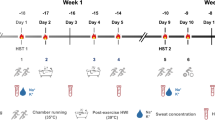Abstract
The present study investigated the effect of 21 days of horizontal bed rest on cutaneous cold and warm sensitivity, and on behavioural temperature regulation. Healthy male subjects (N = 10) were accommodated in a hospital ward for the duration of the study and were under 24-h medical care. All activities (eating, drinking, hygiene, etc.) were conducted in the horizontal position. On the 1st and 22nd day of bed rest, cutaneous temperature sensitivity was tested by applying cold and warm stimuli of different magnitudes to the volar region of the forearm via a Peltier element thermode. Behavioural thermoregulation was assessed by having the subjects regulate the temperature of the water within a water-perfused suit (T wps) they were wearing. A control unit established a sinusoidal change in T wps, such that it varied from 27 to 42°C. The subjects could alter the direction of the change of T wps, when they perceived it as thermally uncomfortable. The magnitude of the oscillations towards the end of the trial was assumed to represent the upper and lower boundaries of the thermal comfort zone. The cutaneous threshold for detecting cold stimulus decreased (P < 0.05) from 1.6 (1.0)°C on day 1 to 1.0 (0.3)°C on day 22. No effect was observed on the ability to detect warm stimuli or on the regulated T wps. We conclude that although cold sensitivity increased after bed rest, it was not of sufficient magnitude to cause any alteration in behavioural thermoregulatory responses.





Similar content being viewed by others
References
Burke WE, Mekjavic IB (1991) Estimation of regional cutaneous cold sensitivity by analysis of the gasping response. J Appl Physiol 71:1933–1940
Cabanac M (1971) Physiological role of pleasure. Science 173:1103–1107
Cabanac M (1981) Physiological signals for thermal comfort. In: Cena K, Clark J (eds) Bioengineering, thermal physiology, and comfort. Elsevier, Amsterdam, pp 181–192
Convertino VA (2002) Mechanisms of microgravity-induced orthostatic intolerance: implications for effective countermeasures. J Gravit Physiol 9:1–13
Cotter JD, Taylor NA (2005) The distribution of cutaneous sudomotor and alliesthesial thermosensitivity in mildly heat-stressed humans: an open-loop approach. J Physiol 565:335–345
Crandall CG, Shibasaki M, Wilson TE, Cui J, Levine BD (2003) Prolonged head-down tilt exposure reduces maximal cutaneous vasodilator and sweating capacity in humans. J Appl Physiol 94:2330–2336
Ertl AC, Dearborn AS, Weidhofer AR, Bernauer EM, Greenleaf JE (2000) Exercise thermoregulation in men after 1 and 24 hours of 6 degrees head-down tilt. Aviat Space Environ Med 71:150–155
Fortney SM, Schneider VS, Greenleaf JE (1996) The physiology of bed rest. In: Fregly MJ, Blatteis CM (eds) Handbook of physiology. Oxford University Press, Oxford, pp 889–939
Fortney SM, Mikhaylov V, Lee SM, Kobzev Y, Gonzalez RR, Greenleaf JE (1998) Body temperature and thermoregulation during submaximal exercise after 115-day spaceflight. Aviat Space Environ Med 69:137–141
Golja P, Eiken O, Rodman S, Sirok B, Mekjavic IB (2002) Core temperature circadian rhythm during 35 days of horizontal bed rest. J Gravit Physiol 9:P187–P188
Golja P, Kacin A, Tipton MJ, Eiken O, Mekjavic IB (2004) Hypoxia increases the cutaneous threshold for the sensation of cold. Eur J Appl Physiol 92:62–68
Greenleaf JE (1989) Energy and thermal regulation during bed rest and spaceflight. J Appl Physiol 67:507–516
Greenleaf JE (1997) Exercise thermoregulation with bed rest, confinement, and immersion deconditioning. Ann N Y Acad Sci 813:741–750
Hensel H (1976) Correlations of neural activity and thermal sensation in man. In: Zotterman Y (ed) Sensory functions of the skin in primates with special reference to man. Pergamon Press, Oxford, pp 331–353
Kenshalo DR (1976) Correlation of temperature sensitivity in man and monkey, a first approximation. In: Zotterman Y (ed) Sensory functions of the skin in primates with special reference to man. Pergamon Press, Oxford, pp 205–330
Mekjavic IB, Golja P, Tipton MJ, Eiken O (2005) Human thermoregulatory function during exercise and immersion after 35 days of horizontal bed rest and recovery. Eur J Appl Physiol 95:163–171
Panferova NE (1976) Cardiovascular system during hypokinesia of varying duration and intensity. Kosm Biol Aviakosm Med 10:15–20
Panferova NE, Anisimova IV, Pavlova LS, Poliakov VM (1989) Measurement of the temperature of deep-seated tissues in healthy men during hypokinesia. Kosm Biol Aviakosm Med 23:42–46
Pavy-Le Traon A, Heer M, Narici MV, Rittweger J, Vernikos J (2007) From space to Earth: advances in human physiology from 20 years of bed rest studies (1986–2006). Eur J Appl Physiol 101:143–194
Rimmer DW, Dijk D-J, Ronda JM, Hoyt R, Pawelczyk JA (1999) Efficacy of liquid cooling garments to minimize heat strain during space shuttle deorbit and landing. Med Sci Sports Exerc 31:S305
Rubinstein EH, Sessler DI (1990) Skin-surface temperature gradients correlate with fingertip blood flow in humans. Anesthesiology 73:541–545
Taylor HL, Henschel A, Brozek J, Keys A (1949) Effects of bed rest on cardiovascular function and work performance. J Appl Physiol Behav 2:223–229
Weiss B, Laties VG (1961) Behavioral thermoregulation. Science 133:1338–1344
Wilson TE, Shibasaki M, Cui J, Levine BD, Crandall CG (2003) Effects of 14 days of head-down tilt bed rest on cutaneous vasoconstrictor responses in humans. J Appl Physiol 94:2113–2118
Yogev D, Mekjavic IB (2007) A new method for evaluation of behavioural thermoregulation in humans. In: Mekjavic IB, Kounalakis SN, Taylor NAS (eds) Proceedings of the 12th international conference on environmental ergonomics (ICEE XII), Piran, Slovenia. Biomed, Ljubljana pp 359–360
Zhang H, Huizenga C, Arens E, Wang D (2004) Thermal sensation and comfort in transient non-uniform thermal environments. Eur J Appl Physiol 92:728–733
Acknowledgments
This work was supported, in part, by a Knowledge for Security and Peace Grant to I.B.M. from the Ministry of Defence (Republic of Slovenia), the Italian Space Agency (Osteoporosis and Muscle Atrophy, OSMA Project) and the Regione Firuli Venezia Giulia (LR11).
Author information
Authors and Affiliations
Corresponding author
Additional information
Communicated by George Havenith, Susan A. Ward.
Rights and permissions
About this article
Cite this article
Yogev, D., Eiken, O., Pisot, R. et al. Effect of 21 days of horizontal bed rest on behavioural thermoregulation. Eur J Appl Physiol 108, 281–288 (2010). https://doi.org/10.1007/s00421-009-1202-7
Accepted:
Published:
Issue Date:
DOI: https://doi.org/10.1007/s00421-009-1202-7




